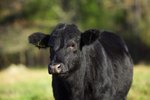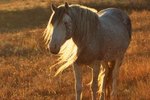
Hardy and well-suited to heat, Brahman and longhorn cattle are common sights on Southern ranches. Brahmans originate from cows native to India, while the huge-horned Longhorn has its roots in Spanish stock. Both stand out from other cow breeds due to their unique appearance.
Brahman Origin
A common breed throughout the United States now, the Brahman breed traces its roots to India. Bos indicus, cows native to India, are called the Sacred Cow of India by people of the Hindu faith. Living in India's harsh conditions for centuries, these cattle developed a resistance to disease and hot conditions. Some 300 of these native Indian cows were brought to the United States in the latter half of the 19th century and early part of the 20th. A few select breeds were chosen to create the American Brahman. Brahman were then crossbred with other breeds of European cattle to produce the modern Brahman.
Longhorn Origin
While Brahmans were carefully crafted for desirable traits, the longhorn flourished without human intervention. Cattle originally brought by Spanish explorers in the late 15th century became feral in what would eventually become Texas. These hardy and heat-resistant cows evolved without human intervention. By the early 19th century, their descendants were the wild Texas longhorns. The Texas longhorn is the only breed of cattle that adapted to life in the United States without help from man.
Brahman Appearance
Brahmans are perhaps most recognized for the large humps above their shoulders, which are more prominent in bulls than cows. Brahmans also have folds of excess skin hanging from their necks that aid in regulating body temperature by exposing a larger surface area of skin. Another trademark feature is their long, floppy ears. Bulls weigh between 1,600 and 2,000 pounds, females slightly smaller. Brahmans have short, glossy coats that reflect sunlight, and heavy pigment that prevents the skin from becoming damaged from intense heat. Brahmans' horns are short, curving up and away from their heads.
Longhorn Appearance
Like Brahmans, longhorns have short, tight hair and are similarly sized, bulls getting slightly larger than Brahmans at up to 2,100 pounds.They have short necks, large heads and long legs. Their most distinguishing feature is their huge expansive pairs of horns. Longhorn horns curve slightly upward, growing outward from the body. Longhorns' horns begin growing when they are 1 month old, and they grow their entire lives. Adult longhorns can have horns that span more than 10 feet. Between these trademark horns, their hair is longer than that on the rest of their bodies.
References
- Oklahoma State University Department of Animal Science: Brahman
- The American Brahman Breeders Association: Information About Brahman Cattle
- Texoma Living: The Texas Longhorn
- Oklahoma State University Department of Animal Science: Texas Longhorn
- Modern Livestock and Poultry Production; James R. Gillespie
Photo Credits
-
Jupiterimages/liquidlibrary/Getty Images




